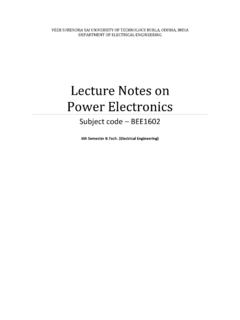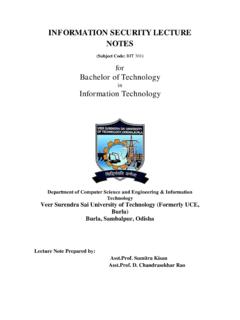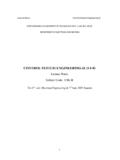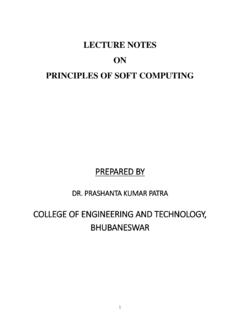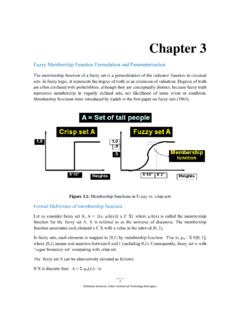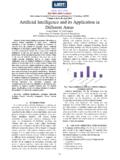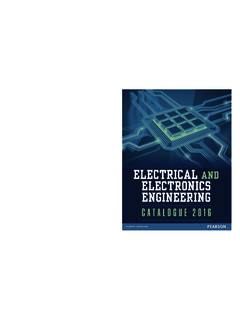Transcription of SOFT COMPUTING (3-1-0)
1 DEPARTMENT OF ELECTRICAL ENGINEERING & ELECTRICAL & ELECTRONICS ENGINEERING VEER SURENDRA SAI UNIVERSITY OF TECHNOLOGY, BURLA, ODISHA, INDIA 8th SEMESTER EE & EEE LECTURE NOTES ON SOFT COMPUTING SUBJECT CODE: BCS 1705 SOFT COMPUTING (3-1-0) MODULE-I (10 HOURS) Introduction to neuro , fuzzy and Soft COMPUTING , fuzzy Sets : Basic Definition and Terminology, Set-theoretic Operations, Member Function Formulation and Parameterization, fuzzy Rules and fuzzy Reasoning, Extension Principle and fuzzy Relations, fuzzy If-Then Rules, fuzzy Reasoning , fuzzy Inference Systems, Mamdani fuzzy Models, Sugeno fuzzy Models, Tsukamoto fuzzy Models, Input Space Partitioning and fuzzy Modeling. MODULE-II (10 HOURS) Neural networks: Single layer networks, Perceptrons: Adaline, Mutilayer Perceptrons Supervised Learning, Back-propagation, LM Method, Radial Basis Function Networks, Unsupervised Learning Neural Networks, Competitive Learning Networks, Kohonen Self-Organizing Networks, Learning Vector Quantization, Hebbian Learning.
2 Recurrent neural networks,. Adaptive neuro - fuzzy information; systems (ANFIS), Hybrid Learning Algorithm, Applications to control and pattern recognition. MODULE-III (10 HOURS) Derivative-free Optimization Genetic algorithms: Basic concepts, encoding, fitness function, reproduction. Differences of GA and traditional optimization methods. Basic genetic programming concepts Applications., MODULE-IV (10 HOURS) Evolutionary COMPUTING , Simulated Annealing, Random Search, Downhill Simplex Search, Swarm optimization BOOKS [1]. , and , neuro - fuzzy and Soft COMPUTING , PHI, 2004, Pearson Education 2004. [2]. Timothy , fuzzy logic with Engineering Applications , McGraw-Hill, International Editions, Electrical Engineering Series, Singapore, 1997. [3]. Davis , Genetic Algorithms: Search, Optimization and Machine Learning , Addison Wesley, , 1989.
3 [4]. , and , Computational Intelligence - PC Tools , AP Professional, Boston, 1996. [5]. Stamatios V. Kartalopoulos Understanding Neural Networks and fuzzy logic Basic concepts & Applications , IEEE Press, PHI, New Delhi, 2004. [6]. Vojislav Kecman, Learning & Soft COMPUTING Support Vector Machines, Neural Networks, and fuzzy logic Models , Pearson Education, New Delhi,2006. [7] S. Rajasekaran & GA Vijayalakshmi Pai Neural Networks, fuzzy logic , and Genetic Algorithms synthesis and application , PHI MODULE-I (10 HOURS) Introduction to neuro , fuzzy and Soft COMPUTING , fuzzy Sets : Basic Definition and Terminology, Set-theoretic Operations, Member Function Formulation and Parameterization, fuzzy Rules and fuzzy Reasoning, Extension Principle and fuzzy Relations, fuzzy If-Then Rules, fuzzy Reasoning , fuzzy Inference Systems, Mamdani fuzzy Models, Sugeno fuzzy Models, Tsukamoto fuzzy Models, Input Space Partitioning and fuzzy Modeling.
4 LECTURE-1 INTRODUCTION: What is intelligence? Real intelligence is what determines the normal thought process of a human. Artificial intelligence is a property of machines which gives it ability to mimic the human thought process. The intelligent machines are developed based on the intelligence of a subject, of a designer, of a person, of a human being. Now two questions: can we construct a control system that hypothesizes its own control law? We encounter a plant and looking at the plant behavior, sometimes, we have to switch from one control system to another control system where the plant is operating. The plant is may be operating in a linear zone or non-linear zone; probably an operator can take a very nice intelligent decision about it, but can a machine do it? Can a machine actually hypothesize a control law, looking at the model?
5 Can we design a method that can estimate any signal embedded in a noise without assuming any signal or noise behavior? That is the first part; before we model a system, we need to observe. That is we collect certain data from the system and How do we actually do this? At the lowest level, we have to sense the environment, like if I want to do temperature control I must have temperature sensor. This data is polluted or corrupted by noise. How do we separate the actual data from the corrupted data? This is the second question. The first question is that can a control system be able to hypothesize its own control law? These are very important questions that we should think of actually. Similarly, also to represent knowledge in a world model, the way we manipulate the objects in this world and the advanced is a very high level of intelligence that we still do not understand; the capacity to perceive and understand.
6 What is AI ? Artificial Intelligence is concerned with the design of intelligence in an artificial device. The term was coined by McCarthy in 1956. There are two ideas in the definition. 1. Intelligence 2. artificial device What is intelligence? Is it that which characterize humans? Or is there an absolute standard of judgement? Accordingly there are two possibilities: A system with intelligence is expected to behave as intelligently as a human A system with intelligence is expected to behave in the best possible manner Secondly what type of behavior are we talking about? Are we looking at the thought process or reasoning ability of the system? Or are we only interested in the final manifestations of the system in terms of its actions? Given this scenario different interpretations have been used by different researchers as defining the scope and view of Artificial Intelligence.
7 1. One view is that artificial intelligence is about designing systems that are as intelligent as humans. This view involves trying to understand human thought and an effort to build machines that emulate the human thought process. This view is the cognitive science approach to AI. 2. The second approach is best embodied by the concept of the Turing Test. Turing held that in future computers can be programmed to acquire abilities rivaling human intelligence. As part of his argument Turing put forward the idea of an 'imitation game', in which a human being and a computer would be interrogated under conditions where the interrogator would not know which was which, the communication being entirely by textual messages. Turing argued that if the interrogator could not distinguish them by questioning, then it would be unreasonable not to call the computer intelligent.
8 Turing's 'imitation game' is now usually called 'the Turing test' for intelligence. 3. logic and laws of thought deals with studies of ideal or rational thought process and inference. The emphasis in this case is on the inferencing mechanism, and its properties. That is how the system arrives at a conclusion, or the reasoning behind its selection of actions is very important in this point of view. The soundness and completeness of the inference mechanisms are important here. 4. The fourth view of AI is that it is the study of rational agents. This view deals with building machines that act rationally. The focus is on how the system acts and performs, and not so much on the reasoning process. A rational agent is one that acts rationally, that is, is in the best possible manner. Typical AI problems While studying the typical range of tasks that we might expect an intelligent entity to perform, we need to consider both common-place tasks as well as expert tasks.
9 Examples of common-place tasks include Recognizing people, objects. Communicating (through natural language). Navigating around obstacles on the streets These tasks are done matter of factly and routinely by people and some other animals. Expert tasks include: Medical diagnosis. Mathematical problem solving Playing games like chess These tasks cannot be done by all people, and can only be performed by skilled specialists. Now, which of these tasks are easy and which ones are hard? Clearly tasks of the first type are easy for humans to perform, and almost all are able to master them. However, when we look at what computer systems have been able to achieve to date, we see that their achievements include performing sophisticated tasks like medical diagnosis, performing symbolic integration, proving theorems and playing chess.
10 On the other hand it has proved to be very hard to make computer systems perform many routine tasks that all humans and a lot of animals can do. Examples of such tasks include navigating our way without running into things, catching prey and avoiding predators. Humans and animals are also capable of interpreting complex sensory information. We are able to recognize objects and people from the visual image that we receive. We are also able to perform complex social functions. Intelligent behaviour This discussion brings us back to the question of what constitutes intelligent behaviour. Some of these tasks and applications are: 1. Perception involving image recognition and computer vision 2. Reasoning 3. Learning 4. Understanding language involving natural language processing, speech processing 5. Solving problems 6.


